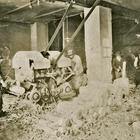In the French Alps the water bubbles and rushes very rapidly. In 1869 Aristide Bergès, a paper manufacturer, had an idea to transfer the energy of the waterfall into electricity. In Lancey, near Grenoble, a hydro-electric sawmill arose. It expanded to a paper mill, and Aristide Bergès (1833-1904) went down in history as the promoter of “white coal.” He also thought up the term and named his mill La Houille Blanche (white coal). Hydropower boomed enormously.
The labour movement welcomed the new source of energy, as working with hydro-energy was much cleaner and less dangerous than mining black coal. Unlike black coal, water from the glaciers did not run out, and hardly any human effort was needed to assure its continuous supply. The fact that nobody owned nature and water undoubtedly was the most important asset of hydropower.
But there was a drawback. With the success of hydropower, many people bought land in the Alps to exploit the glacier water, and they would divert the current when needed. 'The capitalists begin to own the water!', French socialists complained at the end of the nineteenth century. Read more about the present debate on hydropower on International Rivers.org
The production process at the paper mill was photographed in 1882 and 1883. Auguste Fabre composed a photo album: La Houille Blanche (Call no BG T2/30).
Click on the picture for a larger version. From left to right:
The mill at Lancey - Sawmill - Clearing away the bark by machine
Slitting - Removing the knots - Sieving chips of wood
Paper machine - Cutting machine - Sorting out the sheets
Control room - Wrapping up the paper - Clearing away the bark by hand, c 1870












